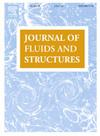Three-dimensional fluid–structure interaction diagnostics using a single camera
IF 3.5
2区 工程技术
Q1 ENGINEERING, MECHANICAL
引用次数: 0
Abstract
A new method for fluid–structure interaction (FSI) diagnostics to simultaneously capture time-resolved three-dimensional, three-component (3D3C) velocity fields and structural deformations using a single light field camera is presented. A light field camera encodes both spatial and angular information of light rays collected by a conventional imaging lens that allows for the 3D reconstruction of a scene from a single image. Building upon this capability, a light field fluid–structure interaction (LF FSI) methodology is developed with a focus on experimental scenarios with low optical access. Proper orthogonal decomposition (POD) is used to separate particle and surface information contained in the same image. A correlation-based depth estimation technique is introduced to reconstruct instantaneous surface positions from the disparity between angular perspectives and conventional particle image velocimetry (PIV) is used for flow field reconstruction. Validation of the methodology is achieved using synthetic images of simultaneously moving flat plates and a vortex ring with a small increase in uncertainty under 0.5 microlenses observed in both flow and structure measurement compared to independent measurements. The method is experimentally verified using a flat plate translating along the camera’s optical axis in a flow field with varying particle concentrations. Finally, simultaneous reconstructions of the flow field and surface shape around a flexible membrane are presented, with the surface reconstruction further validated using simultaneously captured stereo images. The findings indicate that the LF FSI methodology provides a new capability to simultaneously measure large-scale flow characteristics and structural deformations using a single camera.
利用单摄像机进行三维流固相互作用诊断
提出了一种利用单光场相机同时捕捉时间分辨三维三分量(3D3C)速度场和结构变形的流固耦合诊断方法。光场相机对传统成像镜头收集的光线的空间和角度信息进行编码,从而允许从单个图像中对场景进行3D重建。在此能力的基础上,开发了一种光场流固相互作用(LF FSI)方法,重点关注低光通道的实验场景。采用适当的正交分解(POD)对同一图像中包含的粒子和表面信息进行分离。引入了一种基于相关深度估计的流场重建技术,利用角度视差重建瞬时表面位置,而传统的粒子图像测速法(PIV)用于流场重建。该方法的验证是使用同时移动的平板和涡流环的合成图像来实现的,与独立测量相比,在流量和结构测量中观察到的~ 0.5微透镜下的不确定性略有增加。通过实验验证了该方法在不同颗粒浓度流场中沿相机光轴平移的平板。最后,同时重建了柔性膜周围的流场和表面形状,并使用同时捕获的立体图像进一步验证了表面重建。研究结果表明,LF FSI方法提供了一种使用单个相机同时测量大规模流动特性和结构变形的新能力。
本文章由计算机程序翻译,如有差异,请以英文原文为准。
求助全文
约1分钟内获得全文
求助全文
来源期刊

Journal of Fluids and Structures
工程技术-工程:机械
CiteScore
6.90
自引率
8.30%
发文量
173
审稿时长
65 days
期刊介绍:
The Journal of Fluids and Structures serves as a focal point and a forum for the exchange of ideas, for the many kinds of specialists and practitioners concerned with fluid–structure interactions and the dynamics of systems related thereto, in any field. One of its aims is to foster the cross–fertilization of ideas, methods and techniques in the various disciplines involved.
The journal publishes papers that present original and significant contributions on all aspects of the mechanical interactions between fluids and solids, regardless of scale.
 求助内容:
求助内容: 应助结果提醒方式:
应助结果提醒方式:


